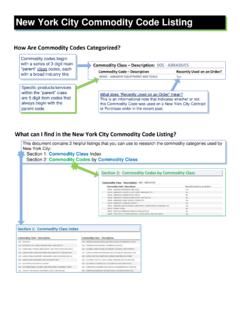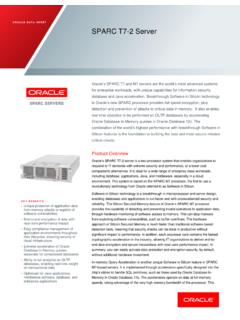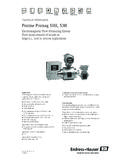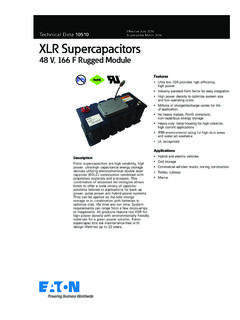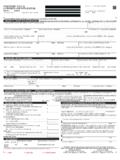Transcription of WARREN OIL COMPANY, INC - New & Used Bus …
1 MATERIAL SAFETY DATA SHEET. WARREN OIL company , INC. CARQUEST Power Steering Fluid Date of Preparation: October 21, 2011. ---------------------------------------- ---------------------------------------- ------------------------------------ SECTION 1: CHEMICAL PRODUCT AND company IDENTIFICATION. ---------------------------------------- ---------------------------------------- ------------------------------------ Product Name: CARQUEST Power Steering Fluid Product Use: Hydraulic Oil Chemical Family: Blend Manufacturer: WARREN Unilube, Inc. CHEMTREC NUMBER. 915 E. Jefferson Ave. Domestic: 800-424-9300. West Memphis, AR 72301 International: 703-527-3887. Phone: 1-800-428-9380.
2 Fax: 870-732-7851. EMERGENCY TELEPHONE NUMBER: (800) 428-9284. MSDS Prepared by: WARREN Oil company , Inc. WHMIS (Canada): THIS PRODUCT IS NOT A WHMIS CONTROLLED SUBSTANCE. ---------------------------------------- ---------------------------------------- ------------------------------------ SECTION 2: COMPOSITION/INFORMATION AND INGREDIENTS. ---------------------------------------- ---------------------------------------- ------------------------------------ Chemical Ingredient Highly refined mineral oils and additives. The highly refined mineral oil contains <3% (w/w) DMSO extract, according to IP346. The base oil may be a mixture of the following CAS #'s: 64742-55-8 and 64742-54-7.
3 ---------------------------------------- ---------------------------------------- ------------------------------------ SECTION 3: HAZARD IDENTIFICATION. ---------------------------------------- ---------------------------------------- ------------------------------------ EMERGENCY OVERVIEW: Oil mist, if generated. HMIS Hazard Rating NFPA Hazard Rating H 1 0. F 1 1. R 0 0. US OSHA HAZARD COMMUNICATION STANDARD: Product assessed in accordance with OSHA 29 CFR. and determined not to be hazardous. WHMIS (Canada): THIS PRODUCT IS NOT A WHMIS CONTROLLED SUBSTANCE. There are no additional ingredients present which, within the current knowledge of the supplier and in the Page 1of 6 MSDS - CARQUEST Power Steering Fluid concentrations applicable, are classified as hazardous to the health or the environment and hence require reporting in this section.
4 Potential Health Effects: Inhalation: Vapor pressure is very low. Vapor inhalation under ambient conditions is normally not a problem. Eye Contact: Expected to be minor eye irritant. Skin Contact: Repeated or prolonged skin contact may cause dermatitis. Ingestion: Not expected to be acutely toxic. Chronic: None known. ---------------------------------------- ---------------------------------------- ------------------------------------ SECTION 4: FIRST AID MEASURES. ---------------------------------------- ---------------------------------------- ------------------------------------ Inhalation: Remove to fresh air. If not breathing, give artificial respiration, preferably mouth to mouth.
5 If breathing is difficult give oxygen. Get medical attention. Eye Contact: Flush eyes with large amounts of water, for at least 15 minutes, until irritation subsides. If irritation persists, get medical attention. Skin Contact: No treatment is necessary under ordinary circumstances. Remove contaminated clothing. Wash contaminated area thoroughly with soap and water. If redness or irritation occurs and persists, seek medical attention. If product is injected into or under the skin, or into any part of the body, regardless of the appearance of the wound or its size, the individual should seek immediate medical attention. Ingestion: If swallowed, DO NOT induce vomiting.
6 If victim exhibits signs of lung aspiration such as coughing or chocking, seek immediate medical attention. ---------------------------------------- ---------------------------------------- ------------------------------------ SECTION 5: FIRE-FIGHTING MEASURES. ---------------------------------------- ---------------------------------------- ------------------------------------ Flammability: NFPA Class-IIIB combustible material. Flashpoint (method): Typical 396 F / 202 C (ASTM D-92). Special Properties: This material can burn but will not readily ignite. This material will release vapors when heated above the flash point temperature that can ignite when exposed to a source of ignition.
7 In enclosed spaces, heated vapor can ignite with explosive force. Mists or sprays may burn at temperatures below the flash point. Autoignition Temperature: No Data Available Extinguishing Media: Use dry chemical, foam, carbon dioxide or water fog. Carbon dioxide and inert gas can displace oxygen. Use caution when applying carbon dioxide or inert gas in confined spaces. Fire-Fighting Instructions: Dense smoke may be generated while burning. Carbon monoxide, carbon dioxide, and other oxides may be generated as products of combustion. Avoid breathing smoke and vapor. Fire-Fighting Equipment: Wear self-contained breathing apparatus and protective clothing. Water may be used to cool containers exposed to heat or flame.
8 Hazardous Combustion By-products: Carbon monoxide, carbon dioxide, aldehydes, ketones, and combustion products of sulfur and nitrogen. ---------------------------------------- ---------------------------------------- ------------------------------------ SECTION 6: ACCIDENTAL RELEASE MEASURES. ---------------------------------------- ---------------------------------------- ------------------------------------ Spill/Leak Procedures: Remove sources of ignition. Contain any spills with dikes or absorbents to prevent migration and entry into sewers or streams. Take up small spills with absorbent pads. Large spills may be taken up with pump or vacuum. ---------------------------------------- ---------------------------------------- ------------------------------------ SECTION 7: HANDLING AND storage .
9 Page 2of 6 MSDS - CARQUEST Power Steering Fluid ---------------------------------------- ---------------------------------------- ------------------------------------ storage Temperature: Ambient storage Pressure: Atmospheric General: Keep container closed. Store in a cool, well-ventilated place. Keep away from heat, sparks and flame. Empty containers may contain residues. ---------------------------------------- ---------------------------------------- ------------------------------------ SECTION 8: EXPOSURE CONTROLS/PERSONAL PROTECTION. ---------------------------------------- ---------------------------------------- ------------------------------------ Exposure Guidelines A: General Product Information If oil mists are generated, observe the OSHA exposure limit of 5 mg/m3.
10 The following are recommended exposure limits for hydrogen sulfide: OSHA PEL 8H TWA 10ppm; 14mg/m3, Ceiling 20 ppm and ACGIH. 8H TWA 10ppm; 14mg/m3. B: Component Exposure Limits No information is available. Engineering Controls Use general ventilation and use local exhaust, where possible, in confined or enclosed spaces. If product is heated above 70 C (155 F) in the presence of water, hydrogen sulfide vapors may be released. Ventilation should be sufficient to keep hydrogen sulfide levels below recommended exposure limits. PERSONAL PROTECTIVE EQUIPMENT. Personal Protective Equipment: Eyes/Face Wear safety glasses. Wear chemical goggles or faceshield if splash or mist occurs.






